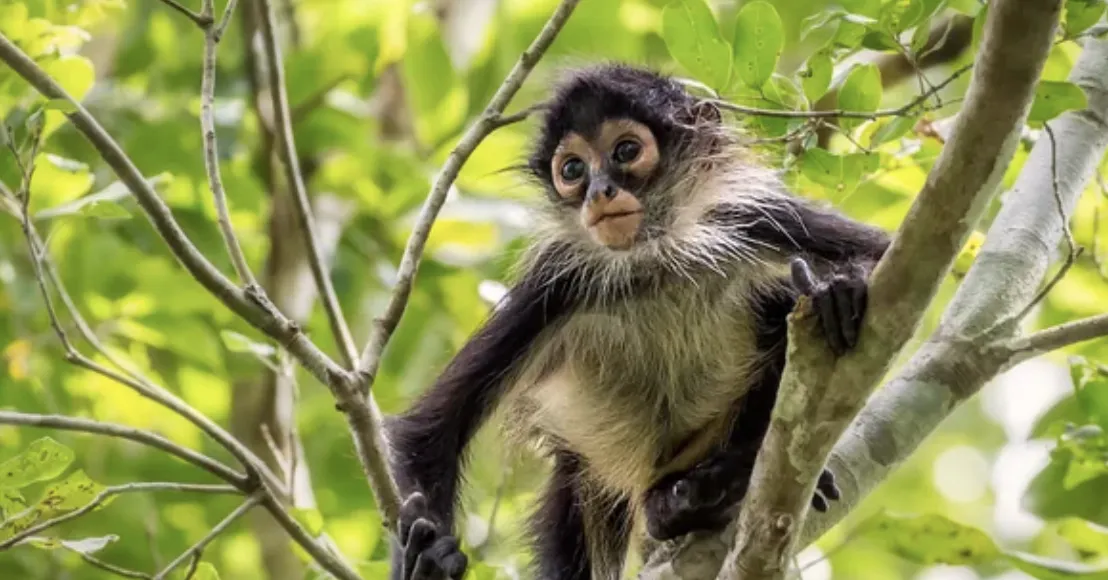
Spider Monkey
by: Elan Saranga
Explore the canopy with one of the most agile primates in the Americas.
Meet the Spider Monkey, an acrobatic denizen of the tropical rainforests!
Overview:
• Spider monkeys are native to the lush rainforests of Central and South America, ranging from Mexico to Brazil and across the Amazon Basin.
• Within the primate family, spider monkeys are classified under the genus Ateles, comprising several species such as the black-headed spider monkey and the brown spider monkey.
• They inhabit the upper layers of the rainforest canopy, where they traverse effortlessly using their long limbs and prehensile tails.
Physical Description:
Spider monkeys are characterized by their slender bodies, long limbs, and prehensile tails, which serve as an extra limb for grasping branches. They have a sleek coat of fur ranging in color from black to brown or reddish-brown, with lighter patches on the face and belly. Their hands and feet are adapted for gripping and climbing, with long, flexible digits ideal for maneuvering through the treetops.
Diet and Eating Habits:
As primarily frugivorous animals, spider monkeys have a diet consisting mainly of fruits, supplemented with leaves, flowers, and occasional insects. They play a crucial role in seed dispersal within their forest habitats, as they consume a variety of fruits and excrete seeds in different locations while traveling through the canopy.
Behavior and Personality:
Spider monkeys are highly social creatures, typically living in groups known as troops or bands. These groups can vary in size from a few individuals to over 30 members, depending on factors such as food availability and habitat quality. They communicate through vocalizations, facial expressions, and body language, maintaining strong social bonds within their community.
Domestication and Uses:
Spider monkeys have not been domesticated like some other primate species. However, they are sometimes kept in captivity in zoos or research facilities for educational purposes and scientific study. In their natural habitat, they are valued for their role in maintaining the ecological balance of tropical rainforests through seed dispersal and nutrient cycling.
Cultural Significance:
Spider monkeys hold cultural significance in indigenous societies across Central and South America, often featuring in myths, legends, and traditional artwork. They are revered as symbols of agility, adaptability, and harmony with nature, embodying the spirit of the rainforest and its inhabitants.
Economic Importance:
While not directly exploited for economic purposes, spider monkeys contribute to ecotourism in regions where they are found. Wildlife enthusiasts and researchers are drawn to their natural habitat to observe their behaviors and study their ecological role. Additionally, their presence in intact rainforests underscores the importance of preserving these ecosystems for future generations.
Conservation Status:
Several species of spider monkeys are listed as "Endangered" or "Vulnerable" on the IUCN Red List due to habitat loss, fragmentation, and hunting pressures. Deforestation, illegal pet trade, and human-wildlife conflict pose significant threats to their populations. Conservation efforts
focus on habitat protection, anti-poaching measures, and community-based initiatives to mitigate these threats and ensure the long-term survival of spider monkeys.
Takeaway:
The spider monkey, with its remarkable agility and social complexity, epitomizes the wonders of the tropical rainforest. As ambassadors of these biodiverse ecosystems, they remind us of the urgent need to conserve and protect their habitats for the benefit of all life on Earth. By
preserving the rainforests, we not only safeguard the future of spider monkeys but also uphold the ecological integrity of our planet.
